Phonic Ear 560T216 OnWave 216 Transmitter User Manual
Phonic Ear, Inc. OnWave 216 Transmitter Users Manual
Users Manual
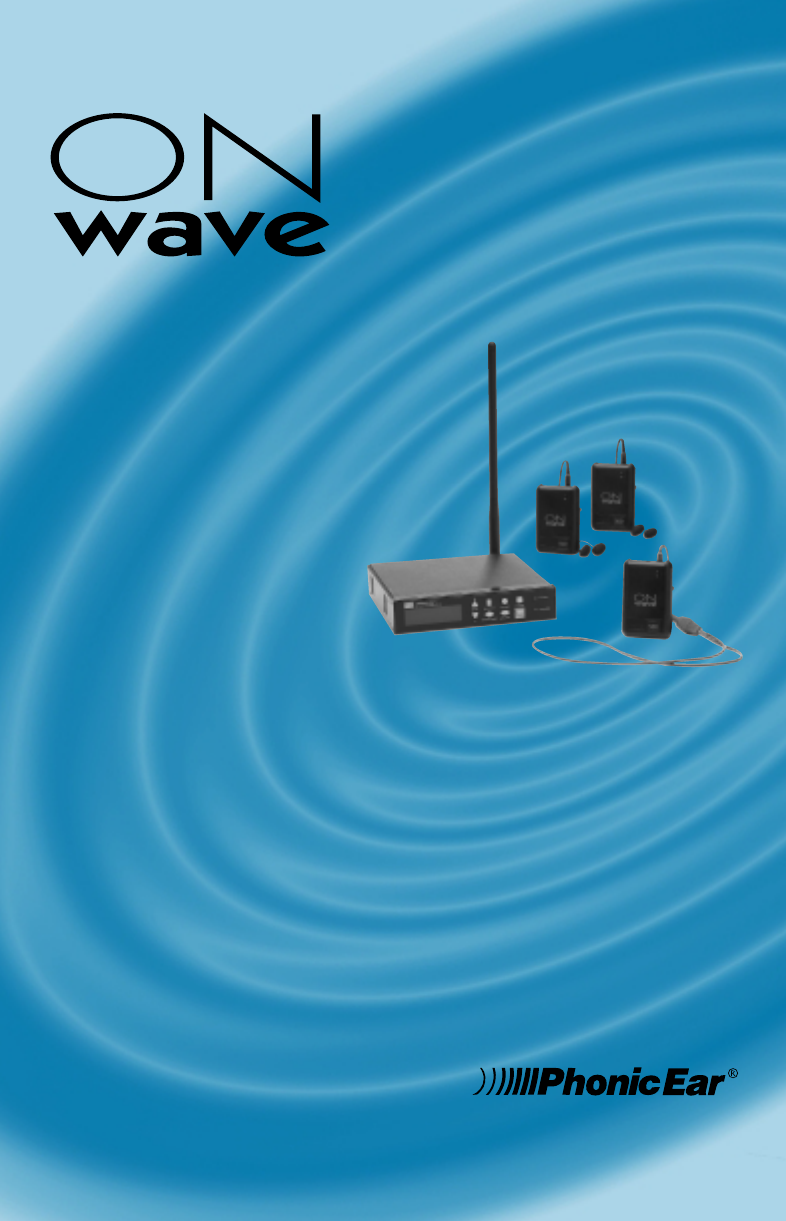
user guide
560T-216 transmitter
221R receiver
216MHz direct digital synthesis FM
specs available on-line at www.phonicear.com
OnWave 216 User Guide 2/4/05 11:02 AM Page 2

FCC and Industry Canada Statements
The 221R complies with Part 15 of the FCC Rules. Operation is subject to the following two con-
ditions: (1) this device may not cause harmful interference, and (2) this device must accept any
interference received, including interference that may cause undesired operation.
This equipment has been tested and found to comply with the limits for a Class B digital device,
pursuant to Part 15 of the FCC Rules. These limits are designed to provide reasonable protection
against harmful interference in a residential installation. This equipment generates, uses and can
radiate radio frequency energy and, if not installed and used in accordance with the instructions,
may cause harmful interference to radio communications. However, there is no guarantee that
interference will not occur in a particular installation. If this equipment does cause harmful interfer-
ence to radio or television reception, which can be determined by turning the equipment off and on,
the user is encouraged to try to correct the interference by one or more of the following measures:
• Reorient or relocate the receiving antenna.
• Increase separation between the equipment and receiver.
• Connect the equipment into an outlet on a circuit different from that to which the receiver
is connected.
• Consult the dealer or an experienced radio/TV technician for help.
This device has been designed to operate with an antenna having a maximum gain of 2.4dB.
Antenna having a higher gain is strictly prohibited per regulations of Industry Canada. The
required antenna impedance is 50 ohms.
The term “IC:” before the radio certification number only signifies that Industry of Canada
technical specifications were met.
This transmitter has been testd to comply with FCC regulations using only antennas and acces-
sories supplied by Phonic Ear. Use of any other antennas or any changes or modifications to this
equipment not expressly approved by Phonic Ear could void the user’s authority to operate the
equipment.
This transmitter is authorized by rule under the Low Power Radio Service (47 C.F.R. Part 95) and
must not cause harmful interference to TV reception or United States Navy SPASUR installations.
You do not need an FCC license to operate this transmitter. This transmitter may only be used to
provide: auditory assistance to persons with disabilities, persons who require language translation,
or persons in educational settings; health care services to the ill; law enforcement tracking services
under agreement with a law enforcement agency; or automated maritime telecommunications
system (AMTS) network control communications. Two way voice communications and all other
types of uses not mentioned above are expressly prohibited.
This device may not interfere with TV reception or Federal Government radar.
Caution: Any changes or modifications to this equipment not expressly approved by Phonic Ear
could void the user’s authority to operate the equipment.
OnWave 216 User Guide 2/4/05 11:02 AM Page 3

table of contents
Transmitter: 560T . . . . . . . . . . . . . . . . . . . . . . . . . . . . . . . . . . . . . 1-2
Band Receiver: 221R. . . . . . . . . . . . . . . . . . . . . . . . . . . . . . . . . . . . . 3
Ground Plane . . . . . . . . . . . . . . . . . . . . . . . . . . . . . . . . . . . . . . . . . . 4
OnWave System Setup and Operation
Understanding hearing assistance . . . . . . . . . . . . . . . . . . . . . . . . . 5
Direct-mount a standard antenna. . . . . . . . . . . . . . . . . . . . . . . . . 5
Remote-mount a standard antenna . . . . . . . . . . . . . . . . . . . . . . . . . . . 6
Mount the transmitter in rack or place on top of rack. . . . . . . . . . 6
Connect line input . . . . . . . . . . . . . . . . . . . . . . . . . . . . . . . . . . . 7
Connect microphone input . . . . . . . . . . . . . . . . . . . . . . . . . . . . . 7
Activate phantom power . . . . . . . . . . . . . . . . . . . . . . . . . . . . . . . 8
Adjust output levels (with adjustable volume) . . . . . . . . . . . . . . . . 8
Adjust output levels (without adjustable volume) . . . . . . . . . . . . . 9
Music or speech? . . . . . . . . . . . . . . . . . . . . . . . . . . . . . . . . . . . . . 9
Set bass cut . . . . . . . . . . . . . . . . . . . . . . . . . . . . . . . . . . . . . . . . 10
Set transmitter band & channel . . . . . . . . . . . . . . . . . . . . . . . . . 10
Set 221R channel . . . . . . . . . . . . . . . . . . . . . . . . . . . . . . . . . . . 11
Walk and listen to confirm quality . . . . . . . . . . . . . . . . . . . . . . . 11
Lock/unlock your settings . . . . . . . . . . . . . . . . . . . . . . . . . . . . . 12
Save settings . . . . . . . . . . . . . . . . . . . . . . . . . . . . . . . . . . . . . . . 12
Receiver batteries. . . . . . . . . . . . . . . . . . . . . . . . . . . . . . . . . . . . 13
How to use the body-worn receiver . . . . . . . . . . . . . . . . . . . . . . 14
Warranty. . . . . . . . . . . . . . . . . . . . . . . . . . . . . . . . . . . . . . . . . . . . . 15
Troubleshooting . . . . . . . . . . . . . . . . . . . . . . . . . . . . . . . . . . . . . . . 16
OnWave 216 User Guide 2/4/05 11:02 AM Page 4

transmitter: 560T
1
3 level -
Reduces output levels when the
volume of the sound source cannot
be adequately adjusted.
1 digital display
4 function
Modifies the operation of other keys
(see step-by-step instructions on the
other side)
2 level +
Increases output levels when the
volume of the sound source cannot
be adequately adjusted
5 speech/music
The speech setting amplifies frequencies
in the 160Hz to 6kHz speech band-
width, and can be further customized
using the bass cut options. The band-
width for the music mode is expanded
to10kHz for a wider frequency response
and fuller sound.
8 channel
Press the Channel key to select from 10
wide-band channels or 40 narrow-band
channels. (Press the Function key followed
by the Channel key to switch between wide
6 line/mic
Press to select line or mic input (see 4b
on page 10).
7 bass cut
Listeners with high-frequency hearing
loss need high frequency emphasis and
low frequency de-emphasis. Press this
key to select 80Hz, 160Hz, or 320Hz
output levels for these individuals. Also
helps eliminate low frequency noise and
60 cycle electrical hum.
12 rf out
Screw in an AT0831 antenna or antenna
cable here (note that connector has left-
handed thread). Canadian models are
required by Industry Canada to feature
connectors unique to Phonic Ear to
prevent the use of non-regulation anten-
nas. Contact your Phonic Ear dealer.
10 rf fault indicator
Lights if antenna is connected incorrectly
or if antenna is being detuned by other
electrical equipment
9 power
11 overload indicator
Lights if input exceeds maximum level for
transmitter. If this lights, reduce input
level to transmitter. (See 5a / 5b on
page 11 )
14 universal line/mic input
Connect to sound system mixer via an
XLR or 1/4in cable. For connection to a
stand-alone mic use an XLR cable (see
page 11). Activate phantom power for
use with condenser mics.
13 speaker level input
To connect to levels of 2V, 10V or
70VRMS use the terminal block input
(sums inputs) and select the line level
setting on the front panel 6 .
15 power input
and narrow-band transmission.Wide-band
channels are indicated by letters, narrow-
band channels are listed numerically.)
Check the front panel display to view the
channel being selected.
OnWave 216 User Guide 2/4/05 11:02 AM Page 5
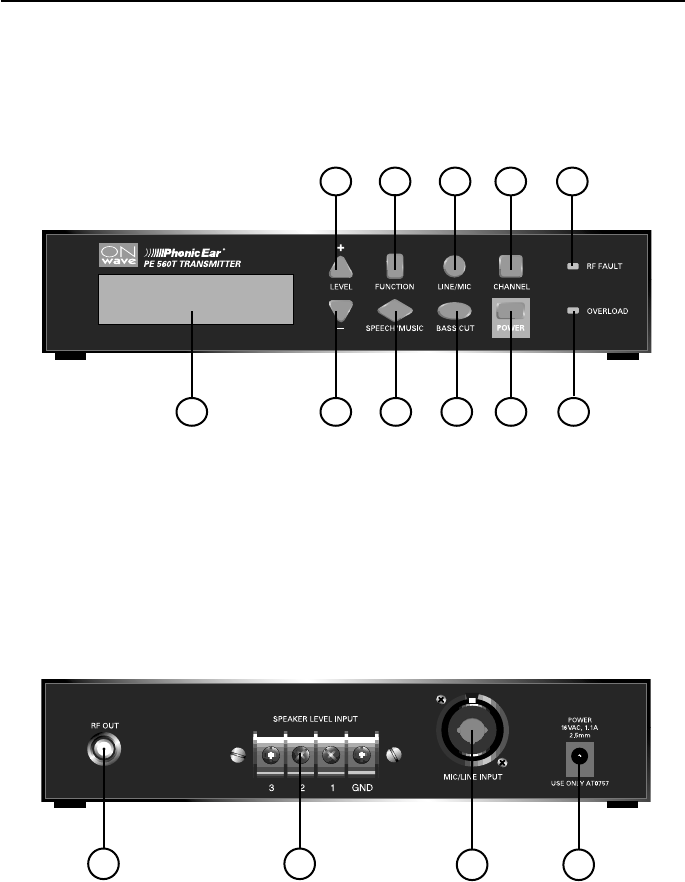
transmitter: 560T (cont’d)
2
2 4 6 8 10
3 5 7 9 111
12 13 14 15
front
back
OnWave 216 User Guide 2/4/05 11:02 AM Page 6
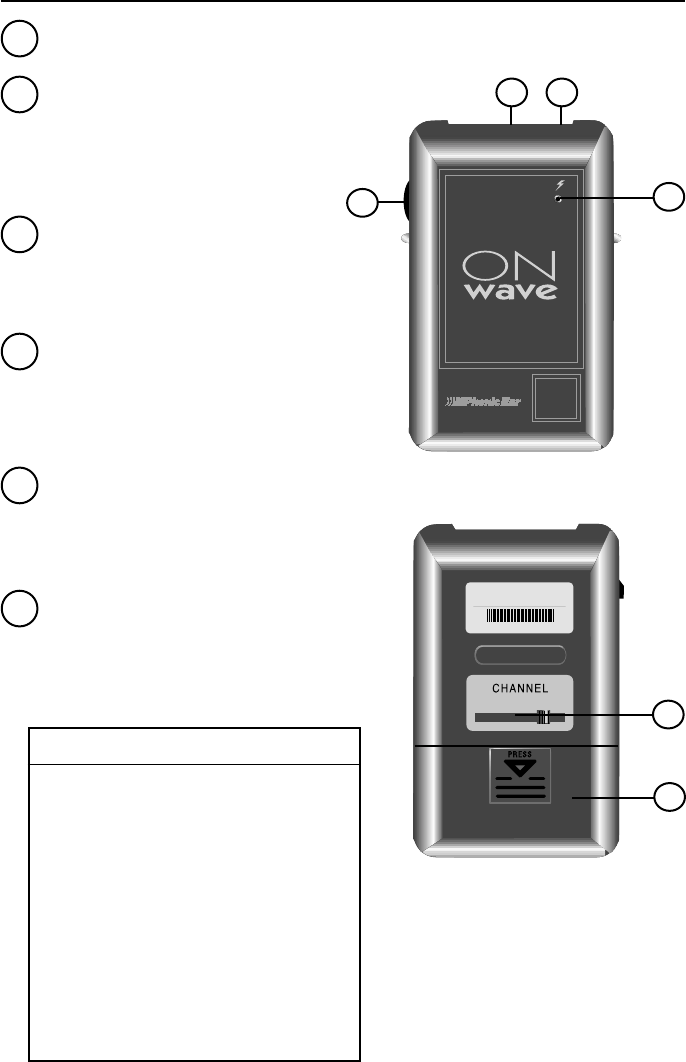
band receiver: 221R
3
24 accessory socket
Connect listening accessories such
as teleloops, earbuds, and headsets.
3.5mm; stereo headset compatible.
25 indicator light
Lights when unit is on; flashes
when batteries are low (2 hours
remaining battery life); lights brighter
when charging
22 volume/power
23 charge socket
1.3mm power jack. Connects to
PE 500C and AT0749 charger to
recharge NiCad batteries (Never
recharge Alkaline batteries!)
26 tuning switch
Choose one of six different channels.
The frequency of each channel
is identified inside the battery
compartment
27 battery door
Use 950mA/Hr rechargeable NiCad
or disposable alkaline batteries (never
recharge alkaline batteries!)
FSR
25
23 24
22
Phonic Ear PE 221R
99 014737
Wide-Band Receiver
P1 P2 P3 P4 P5 P6
26
27
front
back
DIP P1 P2 P3 P4 P5 P6
settings
1111 41 43 49 52 58 60
1110 42 46 49 52 55 59
1101 44 47 49 52 56 59
1100 43 46 49 51 54 60
1011 43 45 49 51 56 59
1010 41 43 49 54 57 60
1001 42 44 52 54 57 59
1000 43 45 53 55 58 60
0111 42 44 47 53 55 58
0110 41 45 47 55 57 60
0101 42 44 47 54 57 59
0100 42 45 46 48 56 58
0011 41 43 48 53 56 58
0010 42 44 51 53 57 59
0001 41 43 46 53 58 60
0000 41 45 48 51 54 58
OnWave 216 User Guide 2/4/05 11:02 AM Page 7
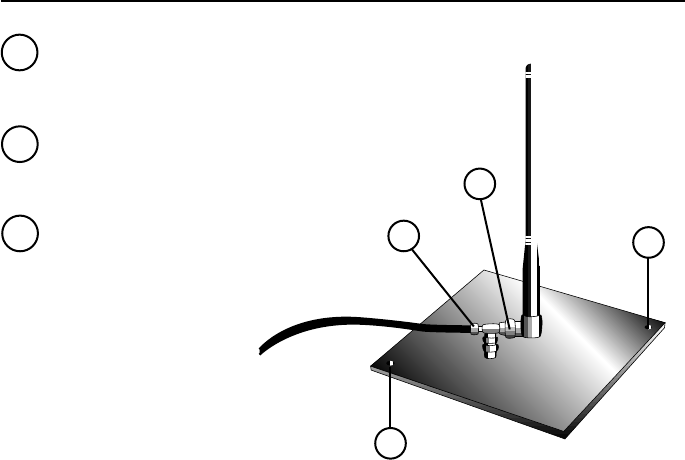
4
ground plane (note that Canadian models have left-handed thread)
16 antenna jack
Attach antenna here
17 cable jack
Attach cable here
18 mounting holes
Use screws to mount on
a wall or, preferably, a
ceiling; may also be
placed on a tabletop
16
17
18
18
OnWave 216 User Guide 2/4/05 11:02 AM Page 8
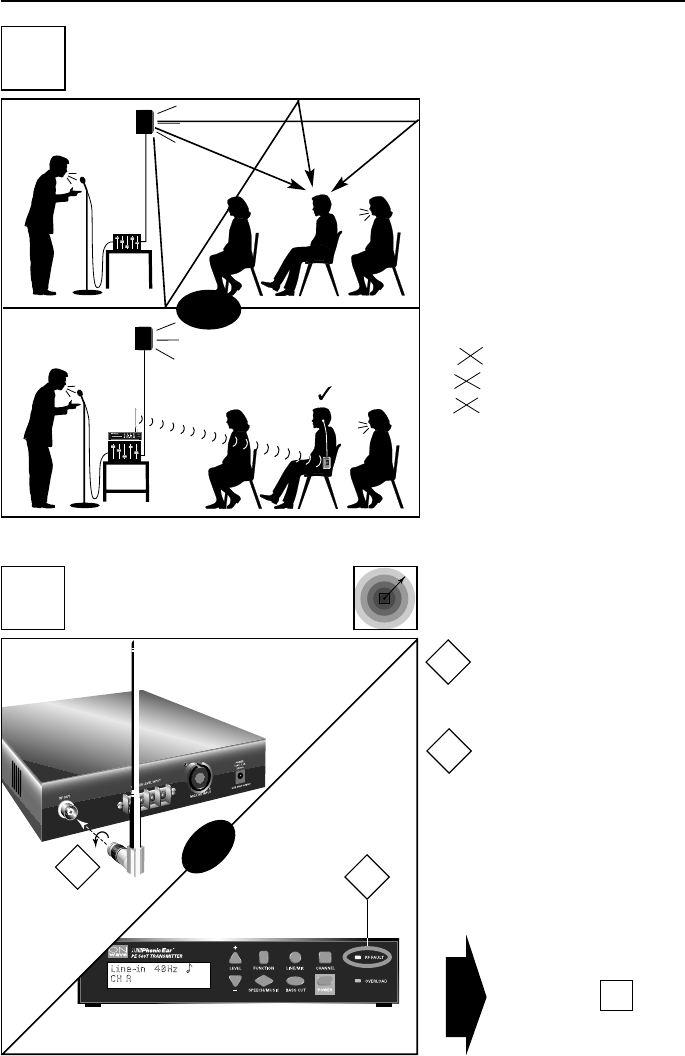
OnWave system setup and operation
5
2a direct-mount a
standard antenna
then
100m
300ft
AT0831
560T-216
1understanding hearing
assistance
but
?
• distance
• noise
• echo
cough!
• distance
• noise
• echo
cough!
without the OnWave system
Attach antenna to back
of transmitter
with the OnWave system
Check RF Fault indicator.
If lit, adjust antenna
connection or remote
mount antenna.
or continue to 2b
2
1
1
2
OnWave 216 User Guide 2/4/05 11:02 AM Page 9
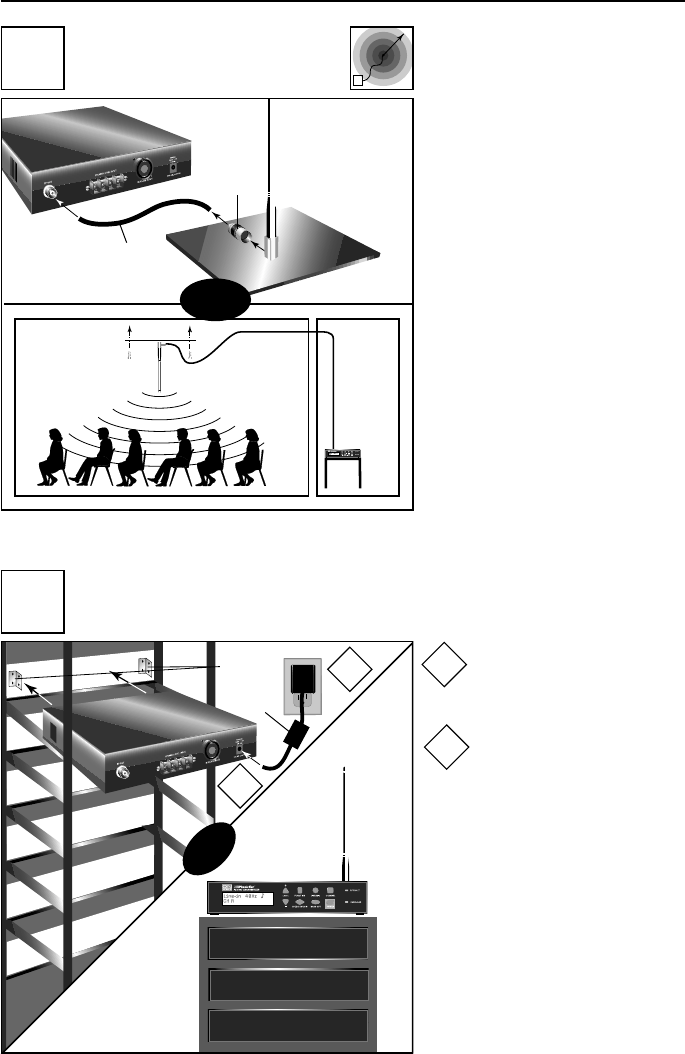
OnWave system setup and operation (cont’d)
6
2b remote-mount a
standard antenna
optimizes transmitter/antenna position
then
100m
300ft
560T-216 ground plane with cable
(850-6302-907)
or
ground plane with
connector kit
(850-6302-905)
560T-216
850-6302-907
AT0775
3mount the transmitter in rack
(requires remote mounting antenna)
or place on top of rack
or
AT0780/
AT0781
AT0786
Plug transformer into
OnWave power input
Plug transformer into
wall socket
2
2
1
1
OnWave 216 User Guide 2/4/05 11:02 AM Page 10
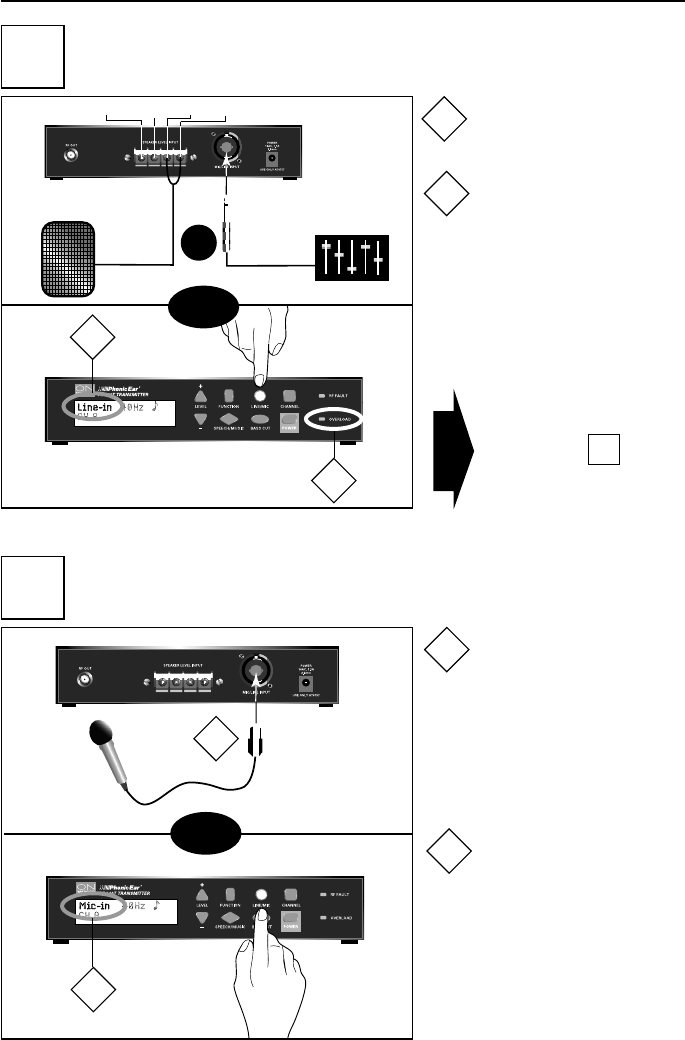
OnWave system setup and operation (cont’d)
7
4a connect line input
or
house system
If overload indicator
lights when connecting
the sound system, use
XLR 250 mVrms input
then
speaker terminal
block
or
.25” pre-amp
100mVrms
70V
rms
10V
rms
2V
rms
GND
4b connect microphone input
then
560T-216
XLR input
2mVrms
Select Line-in
Plug in microphone
Select Mic-in
or continue to 4b
2
1
2
1
2
1
2
1
OnWave 216 User Guide 2/4/05 11:02 AM Page 11
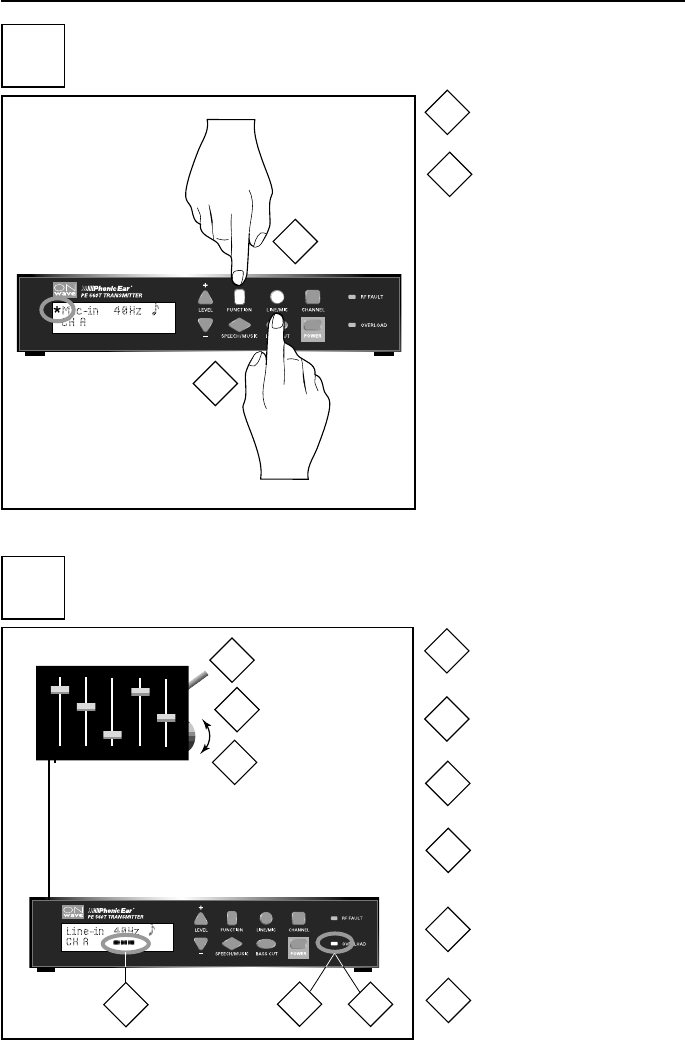
OnWave system setup and operation (cont’d)
8
4c activate phantom power
(for electret condenser mics only†)
Repeat steps to deactivate
phantom power
†Use phantom power only
with condenser microphones.
Plugging dynamic mic in
while phantom power is
activated may damage
the microphone
Press function
Press line/mic
2
1
2
1
5a adjust output levels
(if your house system has adjustable volume)
house system
Increase sound system
volume until...
Turn on and play
test signal
...overload indicator lights
Slowly decrease sound
system volume until...
...overload indicator
goes out
Confirm that meter peaks
with signal
2
1
4
3
6
5
2
1
4
3
65
OnWave 216 User Guide 2/4/05 11:02 AM Page 12
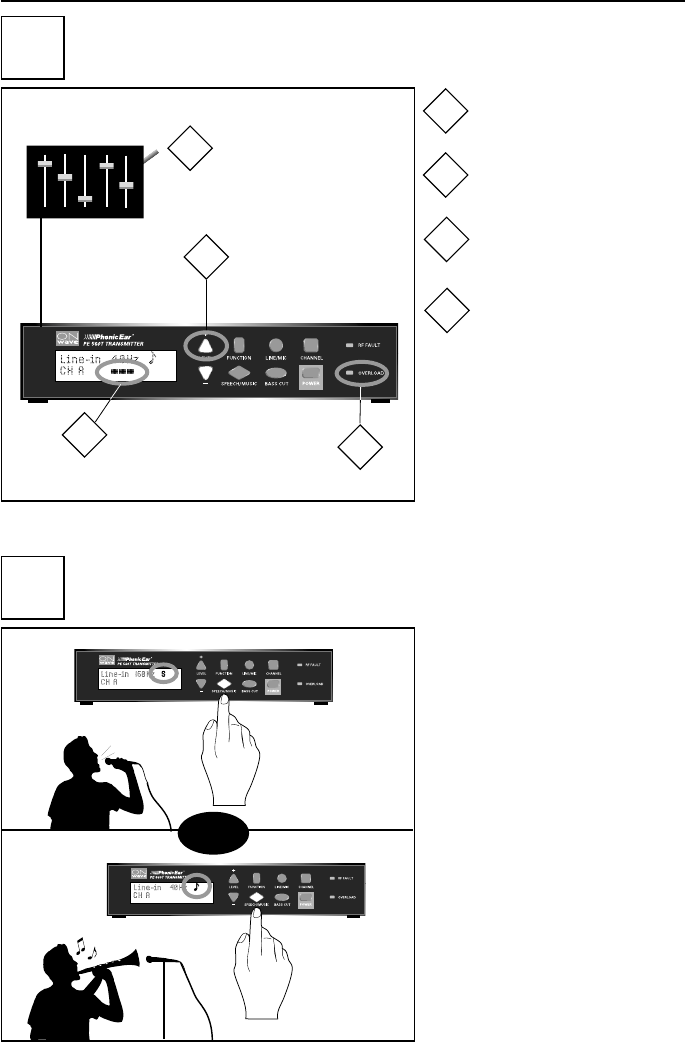
6music or speech?
(set for typical signal content)
or
OnWave system setup and operation (cont’d)
9
5b adjust output levels
(if your house system has no adjustable volume
or if further adjustment is required)
house system
* When transmitter level is
increased, the auto line level
control is activated and signal
strength is automatically adjust-
ed for maximum volume with-
out distortion or clipping.
*
Increase transmitter level*
until...
Turn on and play
test signal
2-3 indicator bars appear
and peak with signal
Confirm that overload
indicator is off
2
1
4
3
2
1
4
3
OnWave 216 User Guide 2/4/05 11:02 AM Page 13
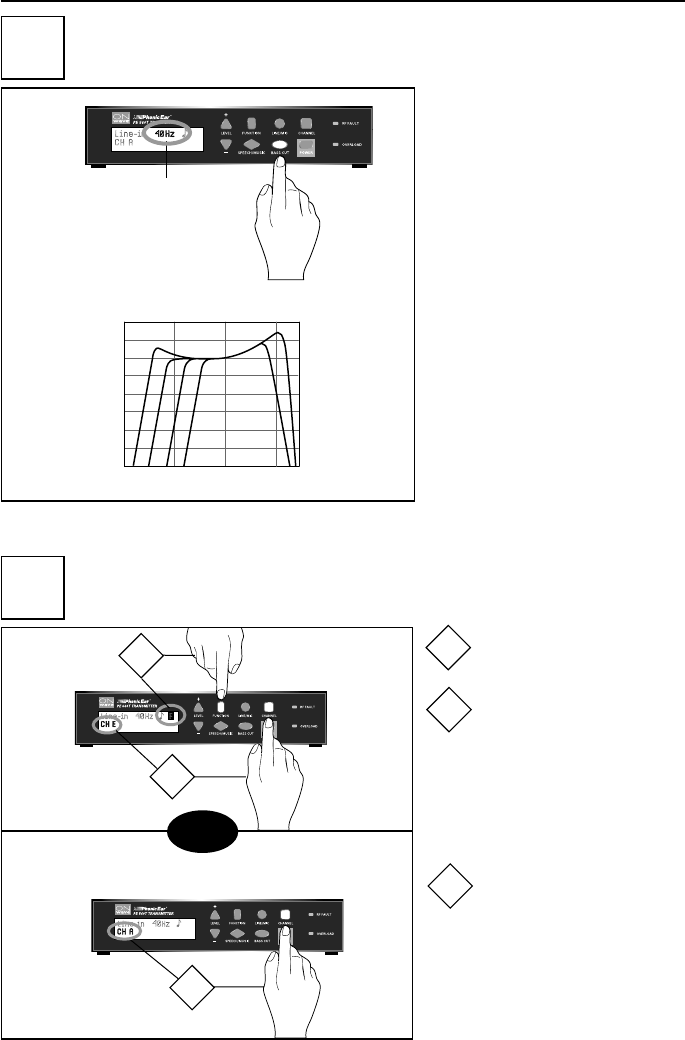
OnWave system setup and operation (cont’d)
10
20
10
0
-10
-20
-30
-40
-50
-60101104
102103
transmitted frequency response
40 Hz
speech
80 Hz
160 Hz
320 Hz
music
7set bass cut
(optimize for listeners or to reduce low-freq noise)
Recommended Standard Setting
Speech: 160Hz
Music: 40Hz
Recommended Noise Reduction Setting
(air conditioning, low frequency hum)
Speech: 160Hz
Music: 160Hz
8a set transmitter band & channel
(optional; must tune your receiver to match!)
then
For narrow-band channel and
frequency information see 506R
receiver diagram on other side.
Press channel to select
wide-band for 500R
(channels indicated by
letters) or narrow-band
for 506R (channels
indicated by numbers)
Press function
Press channel to select
channel within your
chosen band
2
1
3
1
2
3
OnWave 216 User Guide 2/4/05 11:02 AM Page 14
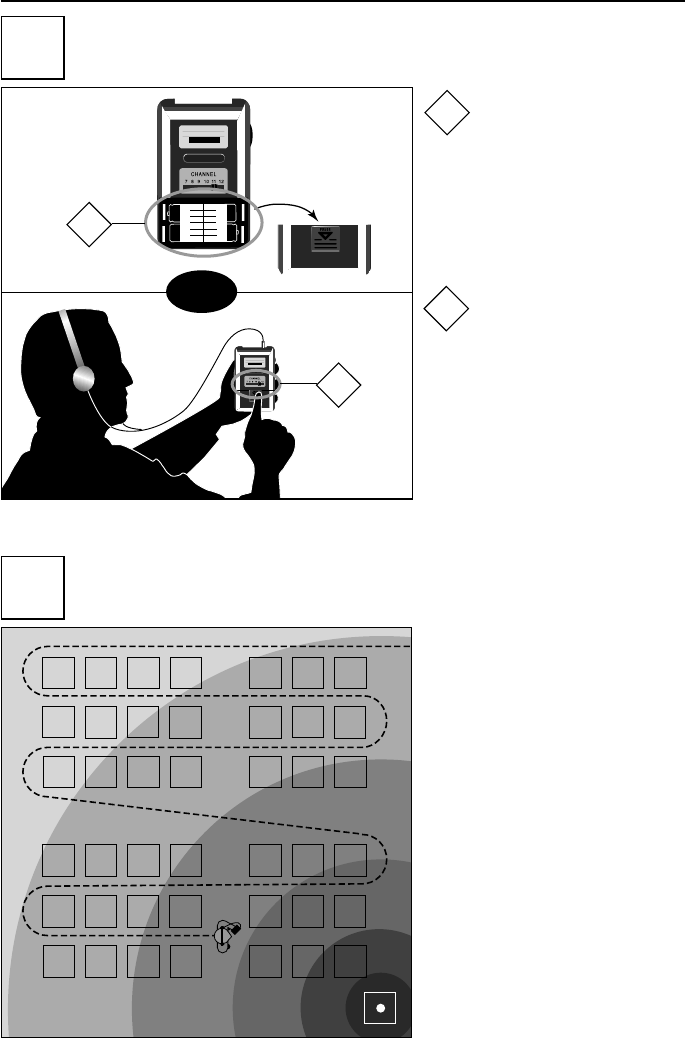
Phonic Ear PE 506R
99 014737
Narrow-Band Receiver
9walk and listen to confirm quality
(reposition antenna if necessary)
8c set 221R channel
(must match your transmitter!)
then
C
H
A
N
N
E
L
N
O
F
R
E
Q
C
O
D
E
7
8
9
10
11
12
1
5
11
14
17
19
+–
– 72 MHz +
Phonic Ear PE 506R
Narrow-Band Receiver
99 014737
Set switch to number
indicated on channel
chart inside 221R
battery compartment
Find number on channel
chart inside battery
compartment of 221R
which matches channel
number on 300T 216
transmitter
2
1
2
1
OnWave system setup and operation (cont’d)
11
OnWave 216 User Guide 2/4/05 11:02 AM Page 15
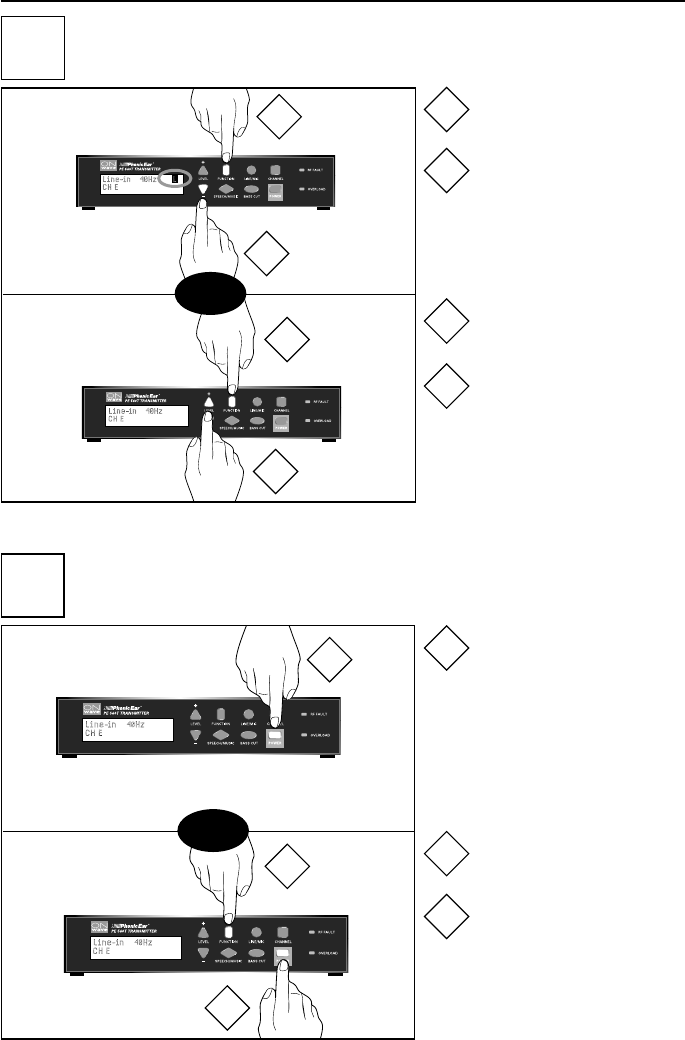
OnWave system setup and operation (cont’d)
12
11 save settings
or
10 lock/unlock your settings
or
saves settings permanently
if unplugging unit or power
outage occurs
saves settings in temporary memory
Press function
Press level - to lock
Press function
Press level + to unlock
Press power to turn unit
off and save settings
Press function
Press power
1
2
3
4
1
2
3
4
1
1
2
1
1
2
OnWave 216 User Guide 2/4/05 11:02 AM Page 16
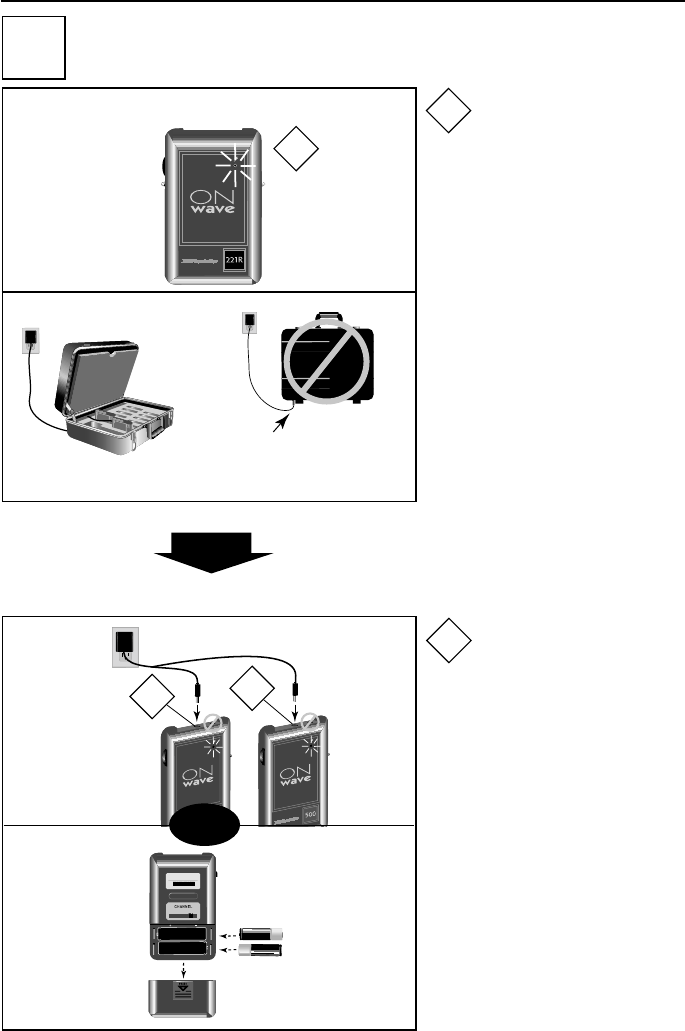
12 receiver batteries
batteries are low
warning!
Place charger case on its side when
connecting to charger cord.
Do not stand charger case on
bottom when charging. Damage
to charger may occur.
then
charge
replace
AT0749 (500R) or AT0534 (506R)
500R or
506R
NOTE: Never recharge
Alkaline batteries
Push off
or
Plug charger cord into
charger jack, not acces-
sory jack
Light flashes when
2 hours of battery life
remain (4 hours with
alkaline battery)
11
2
2
2
OnWave system setup and operation (cont’d)
13
Phonic Ear PE 221R
99 014737
Wide-Band Receiver
P1 P2 P3 P4 P5 P6
OnWave 216 User Guide 2/4/05 11:02 AM Page 17
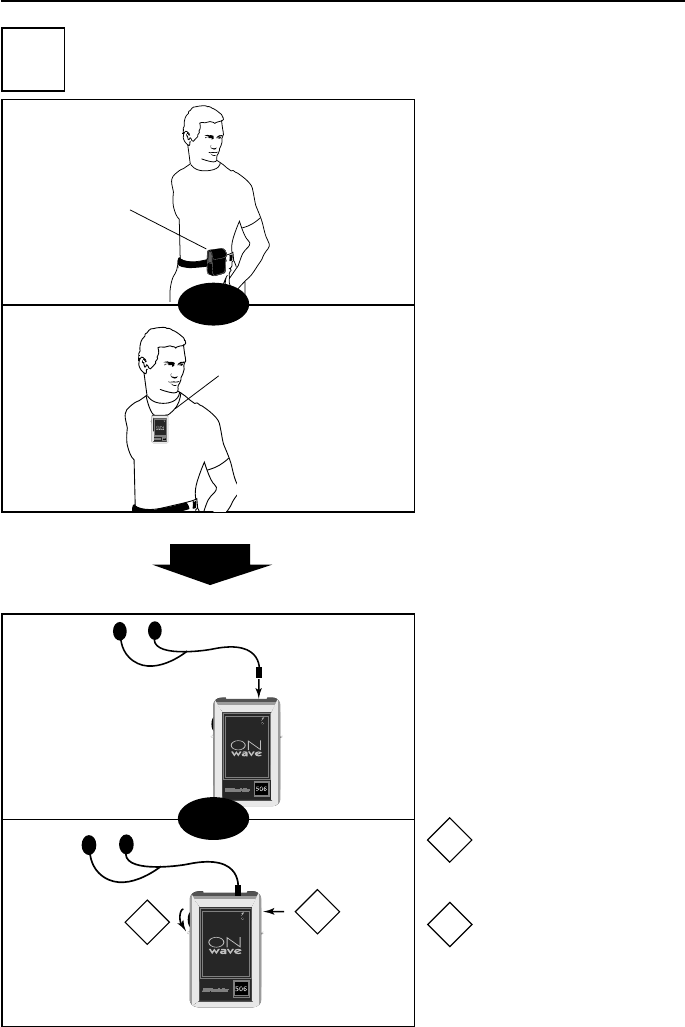
14
OnWave system setup and operation (cont’d)
13 how to use the body-worn
receiver
or
AT0076
lavalier cord
AT0489 wire clip
or
AT0737 pouch
then
then
On/Volume
(verify power light is on)
Switch to channel/
program
1
1
22
OnWave 216 User Guide 2/4/05 11:02 AM Page 18

warranty
time period of warranty
This warranty will go into effect upon the date
of purchase and will stay in effect as long as
the instrument remains the property of the origi-
nal owner. ONWAVE™has a 3-year warranty;
VOCALIGHT™ has a 2 year warranty. All other
products have a 1 year warranty.
what is covered by this warranty
Any electronic component, which because of work-
manship, manufacturing or design defects, fails to
function properly under normal use during the life of
this warranty will be replaced or repaired at no charge
for parts or labor, when returned to the factory
service center. Transportation in and out is paid by
the customer. If it is determined that repair is not
feasible, the entire unit may be replaced with an
equivalent unit upon mutual agreement of the
manufacturer and customer.
what is not covered by this warranty
This limited warranty does not apply to:
1. Malfunctions resulting from abuse, neglect
or accident
2.
I
nstruments connected, installed, used or adjusted
in any manner contrary to instructions provided
by the manufacturer
3. Consequential damages and damages resulting
from delay or loss of this instrument. The exclu-
sive remedy under this warranty is strictly limited
to repair or replacement as herein provided
4. Products damaged in transit unless investigated
by the shipper and returned to the warrantor
with the investigation report
5. Peripheral accessories as itemized within the
product specification sheet as applicable, when
such items are returned within 90 days from
original purchase
6. Batteries if applicable
Phonic Ear Inc. reserves the right to make changes in
the design or construction of any of its instruments at
any time without incurring any obligation to make
any changes whatsoever on units previously purchased.
This warranty is in lieu of all other expressed warranties.
All expressed and implied warranties will terminate
upon the expiration of this written warranty. No repre-
sentative or person is authorized to represent or assume
for us any liability in connection with the sale or use of
our products other than as set forth above.
what to do if you have questions
If you have any questions about service, call the service
department at 800.227.0735, then press 7.
what to do if you need service
If you require service under the warranty terms, obtain
a service order form either online at www.phonicear.
com/support.asp or through our U.S. customer
service department at 800.227.0735, then press 5
(or +1.707.769.1110 outside the U.S.). Fill the form
out completely remembering to include:
1. Description of the problem
2. Your billing address
3. Your shipping address (if different from
billing address)
4. Contact name and phone number
5. A P.O. number if the equipment is not under
a warranty or service contract
Then, carefully package the equipment in the
original shipping container to prevent damage
and send it postpaid to the service center near you:
USA/International:
Phonic Ear Inc.
3880 Cypress Drive
Petaluma, CA 94954-7600
U.S.A.
In Canada:
Phonic Ear Ltd.
10-7475 Kimbel Street
Mississauga, Ontario
L5S 1E7 Canada
what to do if you have questions
If you have any questions about service, call the service
department at 800.227.0735, then press 7.
about your batteries
To ensure that your batteries are as fresh as possible
upon arrival, we have intentionally not installed
them in your equipment.
install your batteries in your equipment now,
then charge overnight before initial use
(see user guide for charging procedure).
avoid battery corrosion
To avoid battery corrosion and damage to your
equipment, do not recharge disposable or
rechargeable alkaline batteries. Before
charging any Phonic Ear equipment make sure
only NiCad or NiMH rechargeable batteries are
installed. As an added precaution, remove batteries
if the equipment will not be used for several weeks.
15
OnWave 216 User Guide 2/4/05 11:02 AM Page 19

16
troubleshooting
no sound
• Verify the channel selected on the receiver matches the channel selected on the transmitter
(see user instructions section 8c )
• Check if the receiver power indicator light is on; if unlit, or flashing, replace or recharge receiver
batteries.
• Check if the transmitter is on (the front panel display window should be lighted).
• Verify the wall transformer is plugged into the transmitter and into a working wall outlet.
flashing light on receiver
• Replace or recharge batteries
sound too low/poor quality sound
• Check the transmitter line level indicators located in the display window. 2-3 bars should peak
with the audio signal. If no bars or only one bar appears, increase the volume on the sound
system and, if necessary, on the transmitter level control. Connect the sound system to the
1/4in input on the transmitter for maximum output levels. Change to higher level output
connection on the sound system.
RF fault indicator is lighted
• Confirm that the antenna is connected properly to the transmitter. Relocate the antenna away from
any metal structures, power cords, or electronic equipment (see user instructions section 2b ).
intermittent audio
• Replace the receiver listening accessory.
• Check the RF fault indicator on the transmitter front panel and follow above instructions if lighted.
• The receiver may be out of range; for areas greater than 100m/300ft use a large area antenna.
overload indicator is lighted
• Confirm that the mic/line setting on the transmitter front panel is correct.
• Reduce the output level on the sound system.
• Connect the sound system to the XLR or speaker level inputs located on the back of the trans-
mitter to reduce level.
• Change to lower output connection on the sound system.
low frequency hum
• Adjust the transmitter front panel bass cut settings to 160Hz or 320Hz
• Relocate the antenna away from electronic equipment, (see user instructions section 2b ).
batteries won’t recharge
• Verify that the wall transformer is plugged into the charger.
• Try different charge cords.
• Verify the receiver indicator light is brighter when the unit is plugged into charger.
• Check the receiver is turned off before charging.
• Check the receiver batteries are Nicad rechargeable.
OnWave 216 User Guide 2/4/05 11:02 AM Page 20

© 2003 Phonic Ear Inc. Phonic Ear and the names of Phonic Ear products are trademarks or registered 821-7289-???/rev. E/??? 903
trademarks of Phonic Ear Inc. in the U.S. and other countries.
us: 800.227.0735, then press 5 • canada: 800.263.8700
outside u.s./canada: Call your local Phonic Ear dealer • website: www.phonicear.com
OnWave 216 User Guide 2/4/05 11:02 AM Page 1